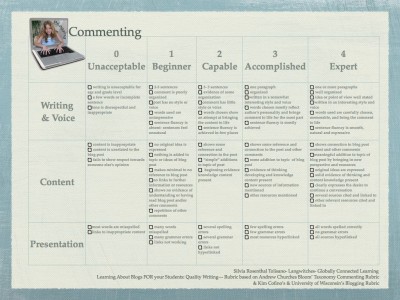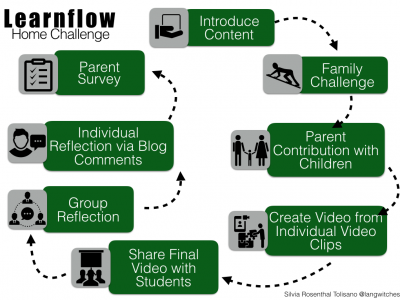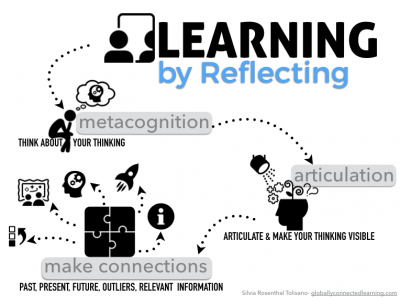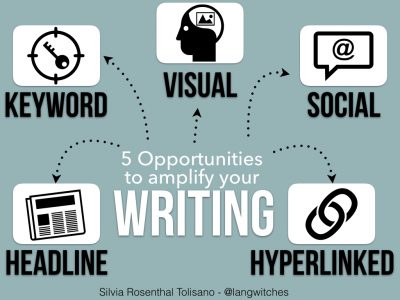What Do You Want to Know About Blogging?

In a recent presentation at Alan November’s BLC17 conference, I had 60 minutes to share my work and thoughts about Blogging as Pedagogy. I asked participants to share questions they had about blogging via a Google Form at the beginning of the session. While I tried to address as many of them as possible during the presentations, 60 minutes got us only that far. Sharing the questions (I have combined a few questions) and answers here on my blog will extend the session across time and physical presence and also allow others interested in the topic to benefit.
How do I introduce blogging to my students so that their voices extend to a broad audience? I’m hoping to learn about supporting students to reach a broader audience than immediate classmates.
I would suggest that the best form of introducing students to a broader audience, is for them to be the audience for someone else. Find, follow, read and comment on other blogs with topics of their interest, other students, experts, authors, scientists, etc. Use #hashtags such as #comments4kids to find blogs to leave comments for and check out other kid’s blogs who write for a global audience (Ex. Random Acts of Kindness & TheLivBits )
How to develop a blogging program in my 4th grade classroom? ( works for all other grade levels as well)
Not an easy question to answer in a few sentences. But you are in luck, I have blogged about it previously and also created an infographic to help you along the way. I have also developed a bite size mini course, available on amplifiEDUcation to help you get start learning about blogging for your students.

How do you assess blogging in the classroom? Is it simply for reflection or is there a rubric for the assignment? Do you use this in conjunction with free writing and/or assigned writing?
A blog can be anything you want it to be. For me it is the perfect platform to make it exactly what you need it to be. If you choose to give your students more freedom, choices and a space for their passion and interests, supporting and fostering their intrinsic motivation, you can do that. If you choose to use your students’ blogging as another form of assessment, you can do that as well. You can also choose to use a combination of both. As a starting point, I would like to recommend the following blogging and commenting rubrics.


How do I make blogging a regular part of my classroom?
I believe the most important piece is a mindshift in believing that blogging is not an add-on activity nor a project (with a beginning date and end) in your classroom. Blogging is seen as a process that documents learning over time, creates a global communication hub, and supports the learner’s meta-cognition and reflective practices. No matter if you have a classroom blog or individual student blogs, use the blog to document learning, reflect on learning, share learning and amplify learning. Make blogging a tool how you accomplish these goals. When you see blogging FOR and AS learning, you will have made it a regular part of how things (learning) are (is) done in your classroom.
How do you discipline yourself to blog regularly? I struggle with the time it takes to craft a blog post.
What works for me, might not work for you. You will have to find your own style to blog regularly. I have found that the more pressure I put on myself to blog, the more stressed I get and the less I write. Blogging is a pleasure for me that becomes a burden, when I give myself deadlines. Another technique that seems to work for me is that I create lots and lots of drafts. I start with titles and save them as drafts, then continue to add to these drafts, as I find little time here and a little time there. Then suddenly, I realize that one of the drafts is ready to publish. With that being said, some bloggers create specific and regular time slots in their calendars to be reminded to blog. You might also want to consider your pre-conceived notion of what is a blog post for you. Blog posts DON’T have to be long. One of the best blog posts I read are sometimes only one or two sentences long. Remember there are no rules. Also remember NOT to be a perfectionist, which is a natural enemy of the blogger! Any blog post published is better than none.
How to take away fear from teachers about putting students blogs out there
I believe that it is not my responsibility to take someone else’s fear away. I believe that is the responsibility of the person who has the fear. They need to educate themselves about the topic, weigh advantages and disadvantages and have the mindset of a risk taker to try something new, move outside their comfort zone, and be willing to learn along the way. I can only suggest ways In this case, I have chosen to share lots and lots of positive examples of student blogs being “out there”. I am not the only one who is sharing these learning opportunities that open up, when students’ work, thoughts, thinking and learning are no longer protected by a walled garden. We need to capture and document evidence of learning opportunities that are being created that support new literacies and skills, vital of learners today that far outweigh potential risks when “putting students blogs out there”.
Tools and ideas to transform education. Sign up below.
Just want to know more ways to use blogging both in the classroom and out.
Have you looked at some of the many Blogging Challenges (for teachers and for students) out there (just google “blogging challenge”)? You can find individual challenges that will serve as a prompt and follow an entire challenge as a guiding path. Extend you notion of blogging beyond text and consider photo blogs (images) , podcasts (audios) or vlogs (videos). Think about collaborative blogging (more than one blog author), quad blogging, curated topic blogging (around specific topics), guest blogging, family blogging month, parent-school communication, extend learning by going beyond communicating but by engaging parents… the list can go on and on…

I wanted to see how you shared student material with a more worldly view but in a safe manner for the student.
It is an unfounded fear that by placing students’ work online, they will be kidnapped or worse killed by a stranger (Of course, on an individual basis, the situation might warrant caution due to real danger and privacy issues (ex. custody battles, children of prominent figures or celebrity, etc.). Let’s remember though that we are talking about sharing academic work (not social blurbs or media). By keeping a few simple precautions in mind, your students will be safe. Teach your younger students not to share their full name online. First name (potentially last name initial) or a blogging alias they can adopt is perfectly fine. Make sure that refrain from sharing identifying details about their lives, such as home address or specific names of places they frequent in addition to time details. (ex. I have gymnastics training at 5 pm every Wednesday at the Starlight Gymnastics Academy). Teach students the difference of taking photos of themselves or other learners that are social (ex. smiley faces towards the camera) or images that show evidence of learning (ex. showing collaboration, communication, level of enthusiasm, etc.) It is perfectly fine to share photos of students’ backs, or what their hands are doing. Showing identifying faces are not always necessary. There is also the option of pixelizing identifying names/faces out of an image. Make sure you expose and teach your students copyright law, so they do not re-share anything that they do not have the right to copy. I would also discuss global perspectives early on. Could someone reading or looking at their work misinterpret their intention, due to cultural differences?
As you can see, blogging allows for an incredible amount of teaching and learning opportunities!
How can blogs be used to add depth to documentation, reflection, peer feedback/review, questioning, and self assessment? How do I use blogging in the classroom? How do I get students to reflect deeply?
The blogging platform is a natural environment to document learning over time. with strategic and thoughtful tagging and categorization, the learner can organize and archive their work to later access, retrieve and connect their artifacts and reflections of learning. With reflective prompts (ex. KWHLAQ), students are guided through the process. Every step is documented on the learner’s blog, supporting the self-assessment process along the way and making it available for feedback via comments. Take a look at making blogging visible for more ideas and examples.

How to amplify the experience for the teachers I work with so that they in turn, create blogging opportunities for their students.
That is a tough one. I am a strong believer of self-motivated learners. All we can do is model and give teachers opportunities and experiences in blogging for their own learning in hopes they will be able to recognize their own learning and translate that experience into their own classroom.
How do I use blogging to teach?
Be open and transparent in your own learning as a blogger and share that experience with your students. Be cognizant to not transfer/substitute analog teaching onto a blogging platform. With that being said, use blogging to amplify your teaching. Grow your visual literacy in communicating with visual media as you teach. Grow beyond communicating via text, but extend your writing with hyperlinked writing. Blogging is authentic real world work, give your students the opportunity to do real work in the world.
How can I use blogging to enhance the learning for my high school students?
Your imagination is the only limit how blogging can enhance learning. Here are a few of my thoughts… Allow you high school students to become experts in an area of their passion (check out genius hours, 20% time or passion projects). Let them ask questions, find answers, curate resources, teach others, reflect on their learning, and disseminate/market/launch their work into the world. Use the blog to give your students choices and a voice. Have them use the blog to learn about marketing, social media, creating a digital footprint and an online portfolio that is already replacing the resume in many places. Have your students connect to the world beyond your classroom. Help them see (through blogging) how people connect via global networks, how writing connects with global ideas and concepts, and how documentation of their learning deepens their metacognition.
Blogging for non verbal students; Blogging for illiterate students?
What a fantastic question to bring up. Thank you! Yes, yes, yes, blogging is a great way to give students a voice, whether they are non verbal due to being new language learners, young students or students who exhibit select mutism, any form of autism or other forms that make them non-verbal in various degrees. Do to devices and apps that make posting to a blogging platform simple and the blogging platforms ability to upload, insert, embed, display and share in many (almost all) different types and media, it makes it a perfect tool for the non verbal and illiterate learners. I am reminded of a student who had chosen to not speak at school. Her blog became a way for her to communicate. On one particular occasion, she had posted a tutorial and review of an iPad app. She had included a suggestion of how she would add certain functionality to the app, if she were to re-design it. Since her blog post was public, the app developer company found her post and commented that they would take her suggestion and include it in their next upgrade. Blogging does not mean writing text alone. Illiterate students are able to blog, via audio, video and images.
Where do I start?
Just do it! Create yourself and account on blogger.com or wordpress.com and write. Write every day… write about your passion, what interests you… don’t be a perfectionist… read lots of other blogs to see what you like about them and what you don’t…tell people about your blog, let them know in a comment on their blog or tweet it out… Just do it! Your first blog post does not have to be anything spectacular! (Take a look at mine from over 11 years ago). Your first blog post will serve as a reminder in the future of HOW FAR YOU HAVE COME . If you are asking how do you start with blogging with your students, take a look at this handy guide from edublogs, but I would still recommend start blogging for yourself is one of the BEST things you can do, if you are considering blogging with your students.
I began blogging, but hit a wall. I know. I know. I need to just write. I’m wondering if it’s worth my time and investment to continue?
You are asking a blogger who has found a way to amplify her learning through her blog. One that has found a way to connect via her blogging with people from around the world. One that has found her voice (even in her third language) through blogging. The process of blogging (from the idea, a topic, through brainstorming, draft writing, visualizing, writing, editing, connecting, linking, sharing, amplifying) has become an integral part of the process of learning. For me it always was worth my time… I hope you will find your reasons to make it worthwhile for you.
How can we use blogging to teach writing skills?
I am so glad you asked Through blogging, you can raise awareness, introduce, support, go in depth, practice and document growth any of the traditionally taught writing skills, BUT blogs can do so much more than a piece of paper or a digital word processing platform. Consider how you can teach writing skills that AMPLIFY writing.

cross posted at langwitches.org/blog
Silvia Tolisano is a Curriculum21 faculty member, author of the book Digital Storytelling Tools for Educators and founder of the Around the World with 80 Schools project. Read more at http://langwitches.org/blog.


